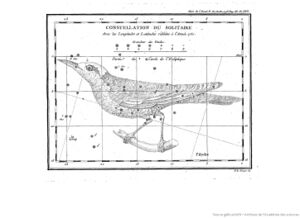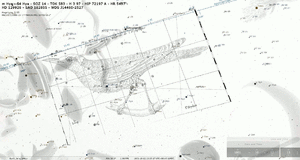Solitaire
This French term was used for the now obsolete constellation Turdus Solitarius (= Solitaire = Noctua).
Etymology and History
The classical constellation Hydra ends with the star pi Hydrae. In early modern time, some astronomers extended the chain of stars towards Libra and even introduced yet another bird on it's longer end (as traditionally, the Raven sits on the tail tip of Hydra). The constellation of "Solitaire" was first depicted in Pierre Le Monnier's contribution to the Histoire de l'Académie royale des sciences ... avec les mémoires de mathématique & de physique... tirez des registres de cette Académie, from the French Academy of Science (Académie des sciences, France) 1776.
Ian Ridpath elaborates that the engraver Yves-Marie Le Gouaz (1742–1816) accompanied Pierre Le Monnier's announcement of the new constellation and states:
Unfortunately the bird shown on the engraving is not the Rodrigues solitaire as Le Monnier had intended, but rather a blue rock thrush, known as the solitaire of the Philippines. Whether the error was due to Le Monnier or Le Gouaz is unknown.
Bode (1801) in his famous Uranographia takes over the idea of this additional bird but depicts it slightly differently,
Transformations/ Variants
IAU Working Group Star Names
The brightest star of historical "Turdus Solitarius" was Sigma Librae, mag. 3.2, named Brachium by WGSN. It was suggested in 2023 to try naming another of its stars, if we can identify them reliably. The French "Solitaire" is an obvious name to use. The biological relative from the neighboring island, the Dodo, is much more popular and even has an emoji. Perhaps we should use this name, too and commemorate extincted animals. Or maybe use a double star for both, Solitaire and Dodo?
The name was discussed and approved by the IAU WGSN in 202x. The WGSN chose ... (not to apply/ to apply the name to a neighbouring star/ to ...) in the IAU-CSN.
Weblinks
- Le Monnier's depiction of the Solitaire (Gallica)
- Bode's depiction of the Solitaire (eRARA Zurich)
- Ian Ridpath's "Star Tales", online edition









